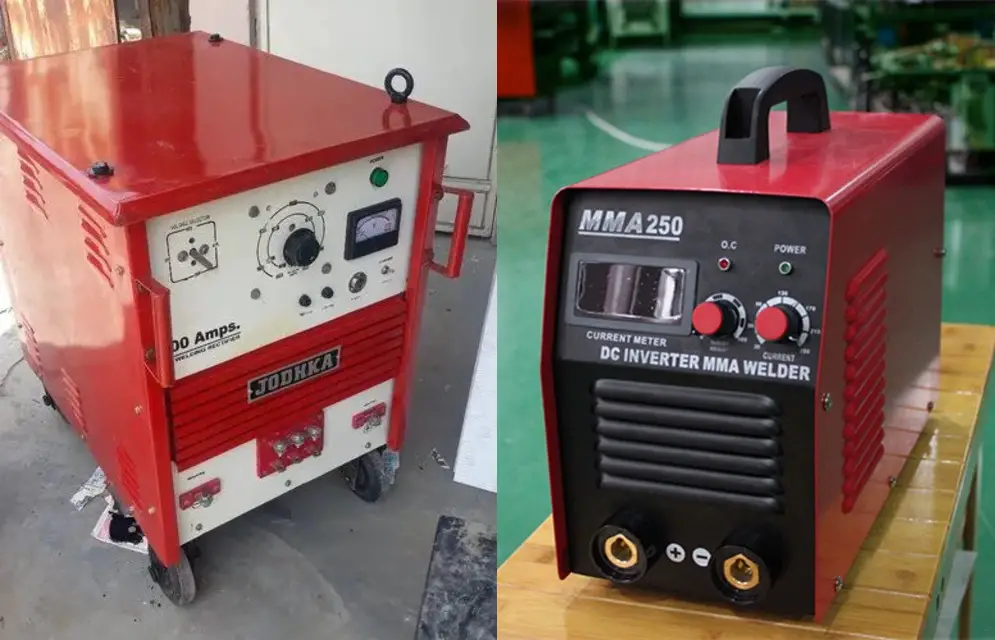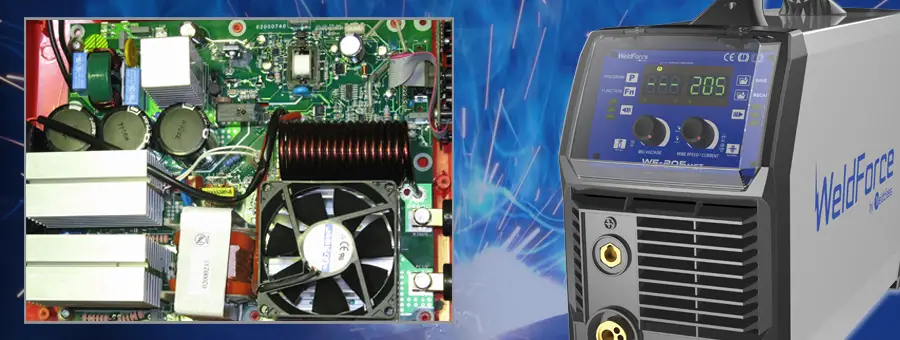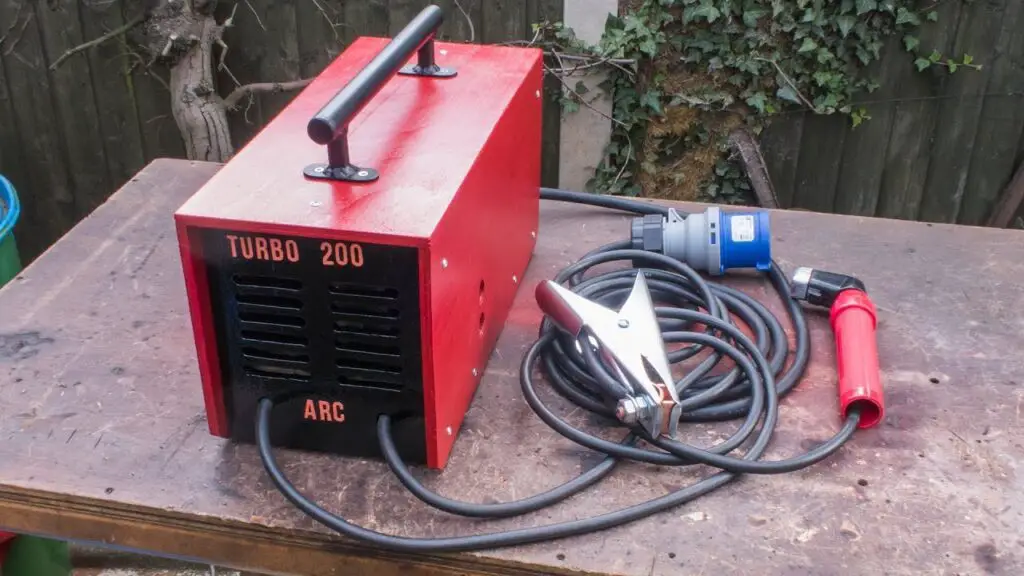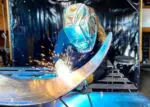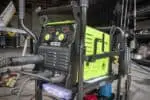Electric welding machines have been in use for over a century. These machines, like any other technology, have improved over the previous decade.
When it comes to transformer or inverter welding machines, many welding professionals have options. However, your preference should be determined by which is the best fit for the job at hand.
In comparison to transformer welders, inverter-based technology is very light. The main distinction is that an inverter welding machine is much more efficient and lighter. However, transformer welding machines are more dependable in the long run and are better suited to harsher environments.
A large, heavy transformer machine won’t be a problem if you’re doing stationary work in a large area. However, if you intend to transport your welder or have limited space, inverter technology will make your life much easier.
Working of Inverter welding machine
An inverter welder is a type of welding machine that employs solid-state electronic components to improve the efficiency of electric current conversion. Inverter welding machines are small, portable, and often the size of a lunchbox.
Inverter-based welders also frequently include a plethora of digital arc control functions. They control arc stability, frequency, arc cone width, bead profile, starting and ending amperage, AC balance, shielding gas flow, wire burnback, inductance, and many other welding variables with hardware and software.
A welding machine with an inverter converts alternating current to a lower usable voltage output. For example, a 240V AC power supply to a 20V DC power output. Inverter-based appliances convert power using a couple of electronic components. 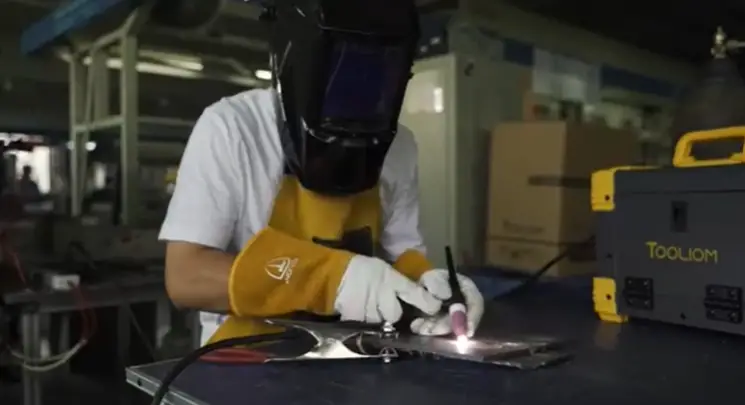 Traditional transformer-based appliances, on the other hand, rely on a single large transformer to control the voltage. An inverter works by increasing the frequency of the primary power supply from 50Hz to 20,000 – 100,000Hz.
Traditional transformer-based appliances, on the other hand, rely on a single large transformer to control the voltage. An inverter works by increasing the frequency of the primary power supply from 50Hz to 20,000 – 100,000Hz.
This is accomplished through the use of electronic buttons that quickly turn on and off the power (up to one-millionth of a second). The size of the transformer can be greatly reduced by controlling the power supply before it enters the transformer.
Advantages of Inverter welder
1.) Compact and lightweight design
The inverter welder is almost everywhere because of its simple design. These welders are more compact than transformer-type equipment and can be easily stored in a smaller space.
2.) Stability, solidity and voltage output
Alternating current is used by transformer welding machines, and appliances do not receive continuous current or output power.
In this situation, these types of equipment require 100-120 reignitions every second. In comparison to transformer welding machines, inverter welding machines may not take as long to generate heat.
3.) Greater efficiency
The inverter welder can be programmed to produce the desired weld bead profile and thickness. The appearance of the weld bead improves dramatically, as does the welding quality.
4.) Low power consumption
These inverter welding machines use little power. When it comes to heat generation and energy consumption, they are the ideal replacement for traditional transformers.
5.) Facility for cooling
These inverter welding machines are equipped with an internal cooling fan. It reduces operating heat and prevents extra heat from being generated. Cooling fans not only prevent machines from overheating, but they also increase the life expectancy of the devices.
6.) IGBT technology
Using any gate current appliance, these inverter welding machines can quickly gather power. Because of its insulated gate bipolar transistor technology, this is possible.
The inverter welder’s switch also operates quickly and efficiently, requiring less energy to complete the final operation.
Working of Transformer welding machine
A traditional transformer welder is a sturdy piece of equipment with limited arc control and considerable weight.
As a result, transformer welders are mostly used in heavy industry or as stationary workhorses in welding shops these days.
They are known to be heavy, but they last a long time. However, due to the size and weight of their transformer core, they are difficult to move and nearly impossible to transport.
These high-performance devices are the industry’s workhorses and require mains power. They are primarily employed in industrial rod welding applications. They are available in capacities ranging from 250A to 600A at 415V.
The transformer welder allows the welder to select the output current by moving one winding closer or farther away from the secondary winding.
It can also move a magnetic shunt inside and outside the transformer’s core by using a series saturating reactor with an adjustable method in series with the secondary current output, or by simply allowing the welder to select the output voltage by tapping on the transformer’s secondary winding. These transformer-style appliances are typically the least expensive.
Advantages of Transformer welder
1.) Dependability
The most contentious aspect of the welder is its dependability. Transformer welders have been undergoing extensive studies, research, and development for nearly 9-10 decades in order to produce reliable, dependable, and sturdy welding machines.
2.) Long lasting
Overall, transformer welding devices are simpler but more reliable. If these devices are properly maintained, they can last for a long time.
Like if you purchase a transformer welder now, it may be possible that your grandkids and your great grand kids will also be able to use them.
3.) Low maintenance
Since it is a heavy and reliable equipment, it also requires less maintenance and care.
Inverter Vs Transformer welding machine- Parameters of differences
1.) The machine’s weight
When compared to transformer welding machines, inverter welders are lighter in weight. They are typically half the weight of many transformer welders. If you need to complete a task in a larger area that is immobile, you can choose a transformer welder.
In the event that you intend to move your welder or work in a confined space, an inverter welder is an obvious choice.
2.) Power and effectiveness
Transformer welding machines have come a long way in the last six to seven decades. Welding machines of high quality have an appealing efficiency quotient while maintaining a fairly stable arc.
Most inverter welders are twice as powerful as transformer welding machines. To achieve comparable degrees of voltage, the inverter welder uses half the amperes as the transformer welder.
For a long time, the inverter welder used direct current. They had a much more stable arc than ordinary DC transformer welders, which were the only alternate current welding machine options available.
3.) Longevity
Transformers have higher duty cycles by definition, so they can handle more heavy-duty work than an inverter machine. Because inverters are new to the market, their long-term reliability is more speculative at this time.
We now know how long transformers last because they’ve been around long enough to be thoroughly studied and improved. Inverter technology, on the other hand, is extremely intriguing because it allows you to pack a lot of power into a small, lightweight package.
4.) Welding environments
Transformer-based machines perform better in dusty and humid environments than inverter-based machines. They have earned a solid reputation for this reason.
However, you must follow the device’s safety rating and the instruction manual. Many inverter welders are more resistant to hazardous conditions than transformer units.
5.) Energy
Inverter welders are far more efficient than traditional transformer units. They can produce the same amount of energy while consuming up to 50% less power. As a result, many inverter machines can be powered by a standard 110V home outlet.
6.) Quality of weld
If you are a welder who works primarily on mild steel, the transformer welding machine is an obvious choice. Inverter welders, on the other hand, can be programmed to do anything. The performance of MIG and TIG inverter welding machines has improved.
And when it comes to innovation and weld quality, the inverter welding machine wins the race.
7.) Duty cycle
Because of the size of the transformer, inverter welding machines can achieve much higher duty cycles in general. Although the smaller parts of an inverter welder heat up quickly, they can be cooled down much more quickly and easily.
8.) Utilization of generator power
Because inverter welding machines can run on smaller portable generators, using generator power is more feasible. It’s not possible with standard transformer welders.
9.) The cost of the equipment
When it comes to initial costs, most transformer welders are less expensive. However, in the long run, an inverter welder can save you a significant amount of money. It all comes down to money and time.
To begin with, inverter welders use less electricity. Inverter welders use less consumables and welding gas due to their increased arc stability.
Inverter vs Transformer Welder Comparison Table
| Parameters | Inverter welder | Transformer welder |
| Weight | Lightweight | Heavyweight |
| Efficiency | High | Low |
| Size | Compact | Huge and bulky |
| Duty cycle | Longer | Short |
| Lifespan | Short | It lasts a very long time. |
| Cost | Not very expensive | Very expensive |
| Cost effective | Yes | No |
| Arc stability | Good | Bad |
| Multiple process possible in one welder | Yes | No |
| Digital arc control | Yes | Not possible |
| Generator support | Bad | Good |
Conclusion
Okay, so if it finally comes down to comparing which is a better welder, then inverter welders have advantages over transformer-based machines, but not all of them may be important to you.
We’ve provided enough information to help you consider your options and determine what’s best for you.

